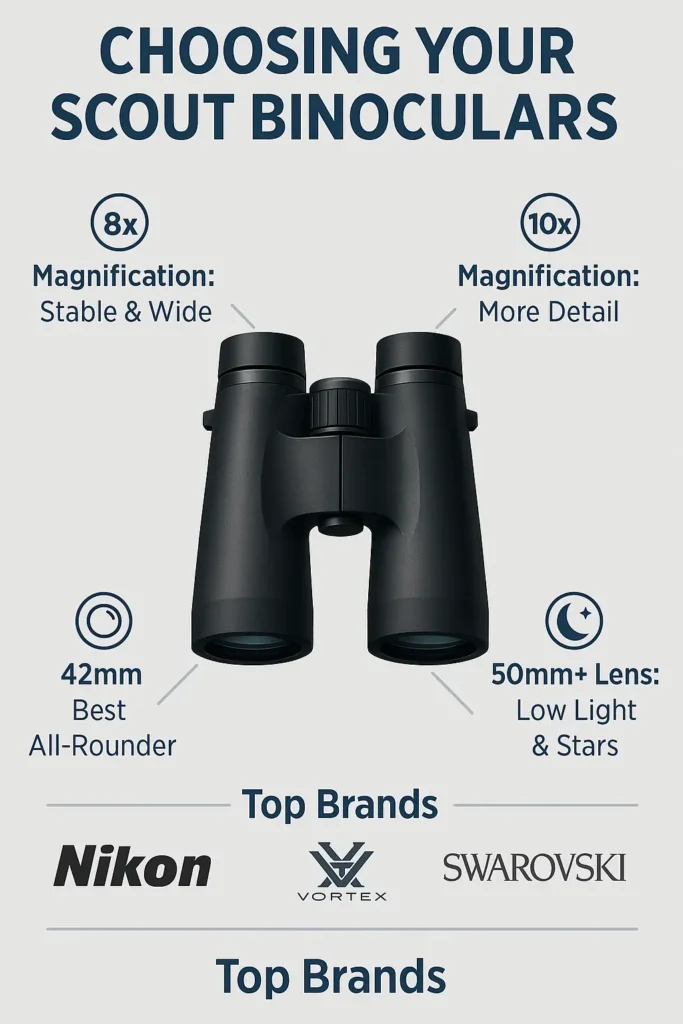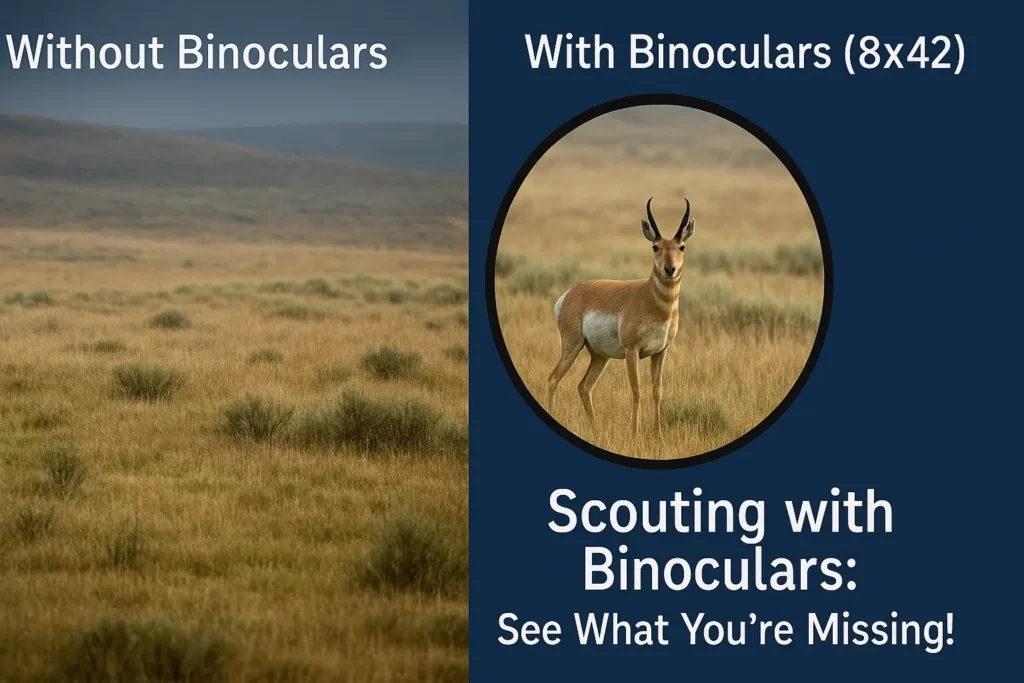Scouting with binoculars and optics helps you see things far away much better. Good binoculars make your outdoor trips, like watching animals or sports, more fun.
In a Nutshell: Scouting with Binoculars
- You will learn what makes good scouting binoculars.
- You will find out about top brands and models.
- You will get simple tips for choosing and using your binoculars.
Thinking about getting a better view outdoors? Good optics can make a big difference. This guide helps you understand Scouting with Binoculars and Optics so you can pick the best pair and use them well.
Estimated reading time: 6 minutes
What Makes Good Scouting Binoculars?

When you look for binoculars, think about these things:
- Magnification: This is how much closer things look. Common types are 7x, 8x, or 10x. More power can make it shaky to hold.
- Objective Lens Size: This is the big lens at the front. A bigger lens (like 42mm) lets in more light. This means brighter views, especially when it’s dim.
- Field of View: This is how wide an area you can see. A wider view helps you follow moving things, like birds.
- Image Stabilization: Some binoculars have this. It helps stop shaky views if your hands move.
- Waterproof and Fog-proof: These are important for outside use. They keep your binoculars safe in rain or damp air.
- Weight and Size: Lighter, smaller binoculars are easier to carry and use for a long time.
Top Brands for Scouting Binoculars
Many brands make good binoculars. Some well-known ones are:
- Nikon: Nikon makes quality optics for bird watching, star gazing, and sports.
- Swarovski: Swarovski Optik offers top-end binoculars. They have clear, sharp images.
- Vortex: Vortex Optics are popular for outdoor trips. They are strong and work well.
- Leica: Leica Camera provides high-quality binoculars that are easy to hold.
- Zeiss: ZEISS binoculars have sleek designs. Their Terra ED models are light and small.
Some good models to check out:
- Celestron Outland X 8×42: These offer good views for a fair price. Celestron makes them great for watching wildlife.
- Nikon Monarch M5: Known for clear views and being tough.
- Swarovski EL 8.5×42: Gives amazing picture quality.
How to Pick the Best Binoculars for You

Choosing the right binoculars is key for good Scouting with Binoculars and Optics. Think about these points:
- Your Main Use: What will you do most? Bird watching might need more power. General outdoor use might favor less power for a steadier view. Planning a specific wildlife viewing tour can also guide your choice.
- Your Budget: How much can you spend? Binoculars can cost from under a hundred to many thousands of dollars.
- Optics Quality: Look for clear views with little blur. Good optics make a big difference.
- Ease of Use: Think about weight, size, and how they feel in your hands. You want them to be comfy.
- Brand Name: Some brands are known for making good, lasting binoculars. You can find many options at stores like Binoculars Canada or Optics Planet.
Tips for Scouting Like a Pro
Using your binoculars well can help you see more.
- Keep Steady: Use a tripod if you have one. Or lean against a tree. This makes the view clearer.
- Scan in Layers: Look at a wide area first. Then zoom in on interesting spots.
- Look Side to Side: Move your binoculars slowly across the area. This helps you cover more ground.
- Use Cover: Hide behind trees or bushes. This way, animals are less likely to see you. This is a good technique for stalking wildlife.
Fun Things to Do with Binoculars in Canada
Binoculars are great for many outdoor activities.
- Watching Wildlife: See animals up close without scaring them. Canada has amazing bear viewing locations.
- Hunting: Spot game from far away.
- Bird Watching: Identify and enjoy birds.
- Looking at Stars: Binoculars can give you a good view of the moon and stars.
More people are enjoying the outdoors. This means more people are buying binoculars. New tech, like image stabilization, is making binoculars even better. People want good quality that lasts and doesn’t cost too much.
See the Outdoors Better
Scouting with binoculars is fun. It makes your time outside better. Pick the right pair. Use good ways to look around. You will enjoy nature even more. New ideas will keep making binoculars a key tool for outdoor lovers in Canada. For a wide selection, you might check out NOCS Provisions or Tract Optics.
Your Questions About Scouting with Binoculars Answered (Simply)
What magnification is best for scouting binoculars?
Are expensive binoculars always better for scouting?
Do I need waterproof binoculars for scouting?
What is field of view in binoculars?
How do I keep my binoculars steady?
Can I use scouting binoculars for stargazing?
What does 8×42 mean on binoculars?


